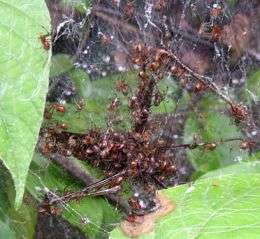Spiders Who Eat Together, Stay Together

(�鶹��ԺOrg.com) -- The ability to work together and capture larger prey has allowed social spiders to stretch the laws of nature and reach enormous colony sizes, UBC zoologists have found.
The findings, published in this week’s edition of the Proceedings of the National Academy of Science, may also explain why social spiders thrive in tropical areas but dwindle with increasing latitude and elevation.
“The size of organisms tends to be constrained by a scaling principle scientists call ‘surface to volume ratio,’” says Leticia Avilés, lead author and associate professor in the UBC Dept. of Zoology. While organisms typically have energetic needs proportional to their volume, they must acquire nutrients through their surface.
“As the organism grows, this surface to volume ratio declines. In a way, this is how nature keeps the sizes of various species in check.”
The same principle may apply to social groups. The surface area of the three-dimensional webs social spiders use to capture prey does not grow as fast as the number of spiders contained in the nests; so number of incoming prey per spider declines with colony size. But Anelosimus eximius, a species of social spider notable for its enormous colony size – some total more than 20,000 individuals – have gained the ability to stretch that law by cooperating and thus capturing increasingly large insects as their colonies grow.
“The average size of the prey captured by the colony increased 20-fold as colony size increased from less than 100 to 10,000 spiders,” says Avilés, who studied the spiders in the wild in Amazonian Ecuador with undergraduate student Eric Yip and graduate student Kimberly Powers.
“So even though the number of prey falls sharply as the colony grows, the biomass that individual spiders acquire actually increases.”
The study also found that large prey, while making up only eight per cent of the colony’s diet, contributed to more than 75 per cent of its nutritional needs.
“But that only works to a certain point,” says Avilés, who adds that the biomass of prey consumed by the colony peaks when the colony reaches between 500 and 1,000 individuals.
As for the scarcity of social Anelosimus species in higher elevations and latitudes, “there simply aren’t enough large insects in those areas to sustain this type of foraging behaviour,” says Avilés.
Provided by University of British Columbia


















